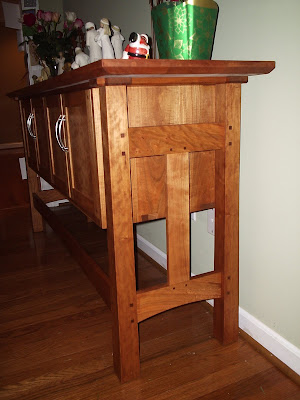I recently had the opportunity to capitalize on a cherry tree which was cut due to storm damage and it had the potential of falling on the home it stood next to. As you can see in the pictures to follow, the tree was cut and we were able to harvest 5 logs from the tree.
The cutters who were hired to fell the tree, cut as needed to safely drop it so no mind was given to cutting the tree in lengths which would yield the most usable amount of lumber. Luckily for the owner and myself...I really didn't care. Being a woodworker, I'll take any opportunity I have to keep a beautiful cherry tree from becoming firewood. As you'll see from the pictures, we still got good length from the tree, four logs were between 6-7', with the butt log being over 12', all diameters being between 24"-32".

The logs moved to the staging area ready for the mill.

This is the start of the process, rolling the log up to and onto the bed of the mill. What you don't see in this picture is the cable which assists rolling the log up the legs and onto the bed. Below is the first pass of the band mill. By process, we made several passes with the mill then turned the log 90 degrees, then again and again until we ended up with a square log called a cant. Follow process by pictures below.




Once we get to the square log, we start making passes to what ever thickness we cut from the cant. We cut anything from 4/4 (1" thick) to 16/4 (4" thick), with a healthy mix of everything in between.

I deem this log Bertha... enough said.

Squaring Bertha, as you can see in this photo, the mill is quite large. This particular model can cut a 21' log 30" in diameter. We calculated a yield of 300 board feet from this one log, not so bad!

My brother and I are carrying a piece cut to be used as a mantle. The client, Nancy (which is in the picture wearing the green shirt) was on site and super excited to see the process of her mantle being cut.

The finished product! Not bad for a days work. I want to give a special thanks to Leo (pictured) and Linda, who allowed me the opportunity to have this beautiful set of logs milled. The trailer was fully loaded, and what you don't see is the bed of the truck is nearly full as well.






 Top to leg connection, simple yet elegant. The same is said the the keyed miter shown below.
Top to leg connection, simple yet elegant. The same is said the the keyed miter shown below.





























